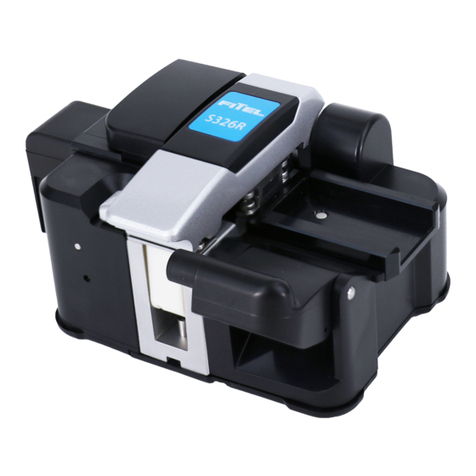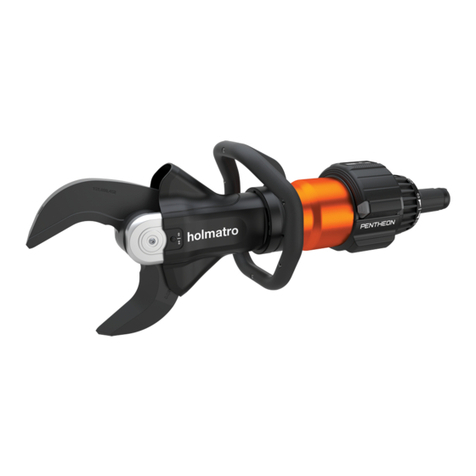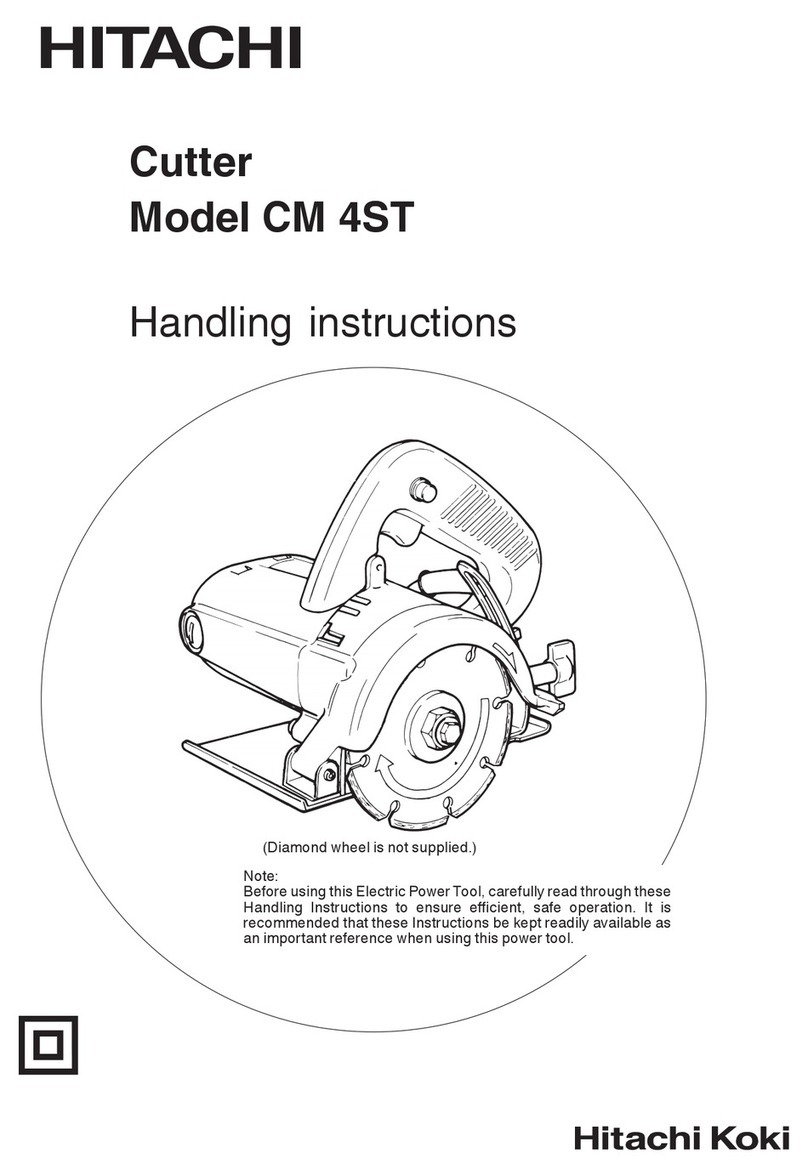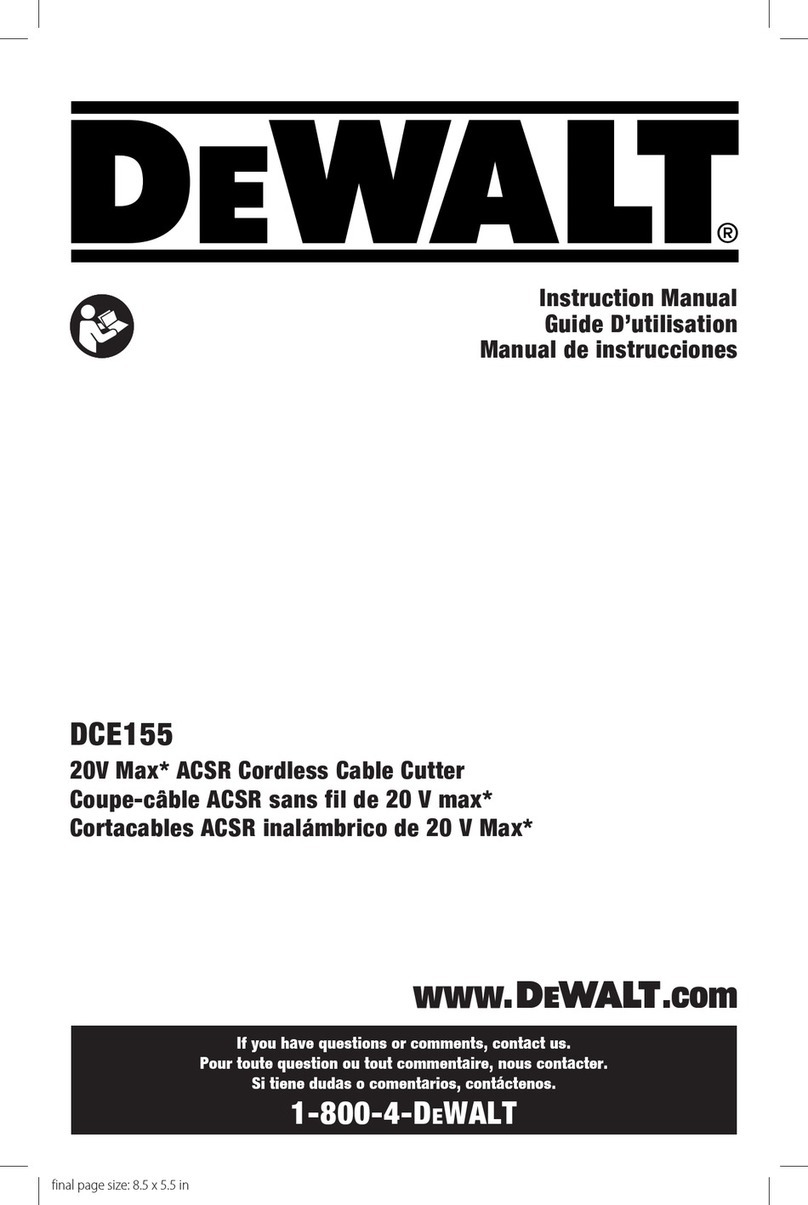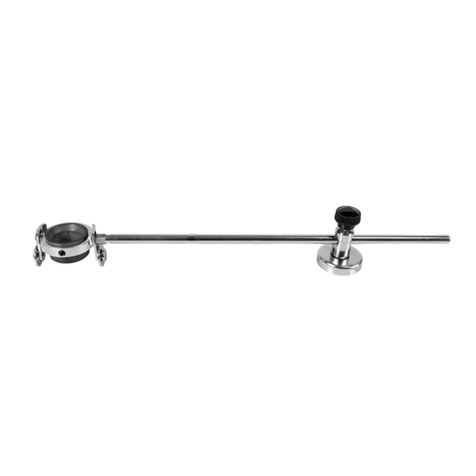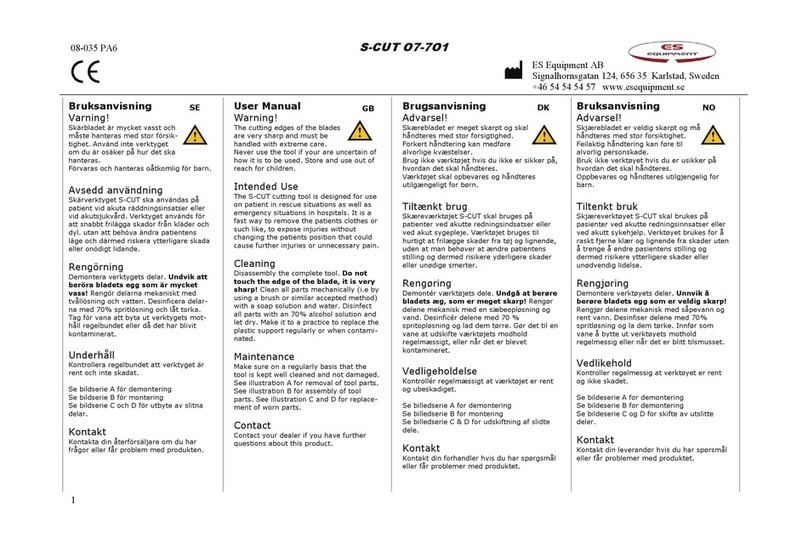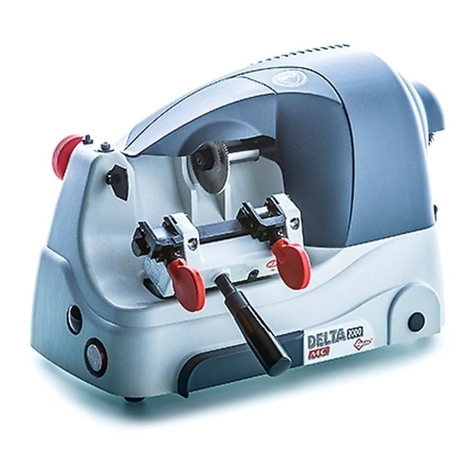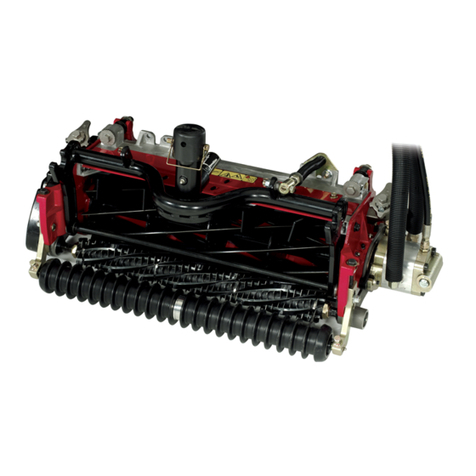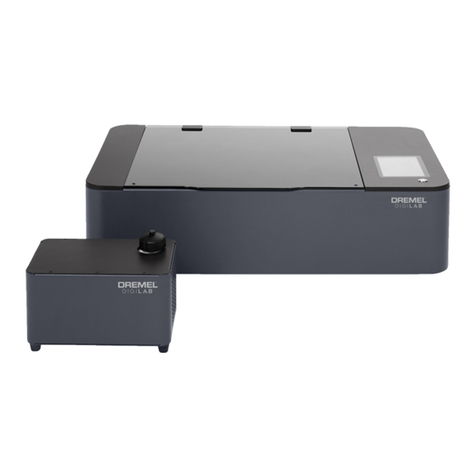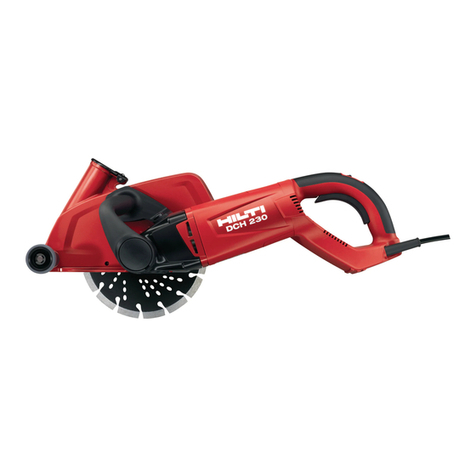Snap Fresh EC0601 User manual

User Manual
geprufte
Sicherheit
Read all safety rules and instructions carefully before operating this tool.
MINI CUTTER
EC0601
www.snapfreshtools.com

Scope of delivery............................................................................................. 3
Component list ........................................................................................ 5
General information ....................................................................................... 6
Explanation of symbols................................................................................. 7
Safety................................................................................................................ 8
General power tool safety warnings.......................................................... 8
Safety warnings for battery cells inside the tool ......................................12
General safety warnings for your battery charger.....................................14
Additional safety instructions for your battery charger..............................15
Operating instructions................................................................................... 16
Removing and installing the blade............................................................16
On/off switch.............................................................................................16
Charging the tool...................................................................................... 17
Charging...................................................................................................17
17
Cutting......................................................................................................
Troubleshooting..............................................................................................18
Maintenance....................................................................................................18
Cleaning...........................................................................................................19
Transport......................................................................................................... 19
Technical data.................................................................................................20
Noise information..................................................................................... 20
Vibration information................................................................................ 20
Environmental protection.............................................................................. 21
Warranty.......................................................................................................... 22
Table of contents

3
Scope of delivery
A
7
6
2 1
3
4
5
8

4
b
a
B2
C
B1
B3
DE

5
On/off switch
Lock-off button
Blade guard
Blade
Blade screw
Charger socket
Charging indicator light
Charger
Component list

6
General information
Reading and storing the user manual
This user manual contains important information on how to use the
4.0V Mini Cutter. Read this user manual carefully, in particular the
safety instructions, before using the product. Failure to follow this
user manual may lead to severe injuries or product damage.
Keep this user manual for further reference. If you pass this product on to a third
party, you must also supply this user manual.
First time users or inexperienced operators pay particular attention to the
operation of the 4.0V Mini Cutter, including details of starting and stopping and
correct use of the 4.0V Mini Cutter on pages 16-18, as well as the maintenance
instructions on pages18-19.
Intended use
This product is for private domestic DIY use only.
It is not suitable for commercial, industrial or trade use.
The tool is intended for cutting flexible, soft materials of up to 6mm in thickness,
such as carpet, PVC, cardboard, leather, fabrics and similar materials.
Use the tool and accessories only for intended applications.

7
To reduce the risk of injury, usermust read instruction manual
Wear earprotection
Wear dust mask
Waste electrical products must not be disposed of with household
waste. Please recycle where facilities exist. Check with your local
authorities or retailer for recycling advice.
Do not burn
Batteries may enter water cycle if disposed improperly, which can be
hazardous for ecosystem. Do not dispose of waste batteries as unsorted
municipal waste.
Li-Ion battery This product has been marked with a symbol relating to
‘separate collection’ for all battery packs and battery pack. It will then be
recycled or dismantled in order to reduce the impact on the environment.
Battery packs can be hazardous for the environment and for human
health since they contain hazardous substances.
For indoor use only(only for charger)
Read the operator’s manual
The output plug is with positive center pole and negative outer pole
This signalsymbol/word refers to a hazard with a medium level of risk that,
if not avoided, may result in death or serious injury.
This signalword warns ofpossible material damage.
Explanation of symbols
Li-Ion
Wear eye protection
Double insulation

8
Safety
General power toolsafety warnings
Read all safetywarnings, instructions, illustrations and
specifications provided withthis power tool.
Failure to follow all
Save allwarnings and instructions for future reference.
1) Work area safety
a) Keepwork area clean and well lit.
Cluttered or dark areas
b)
Do not operate power tools in explosive atmospheres,
such as in the presence of flammable liquids, gases or dust.
c) Keepchildren and bystandersaway while operating a
power tool.
Distractions cancause you to lose control.
2) Electrical safety
a) Power tool plugs must match the outlet. Never modify
the plug in any way. Donot use any adapter plugs with
earthed (grounded)power tools.
Unmodified plugs and
b) Avoid body contact with earthed or grounded surfaces,
such as pipes, radiators, ranges and refrigerators.
There is
instructions listed below may result in electric shock, fire and/ or
serious injury.
The term “power tool” in the warnings refers to your mains-
operated (corded) power tool or battery-operated (cordless) power tool.
invite accidents.
Power tools create sparks which may ignite the dust or fumes.
matching outlets will reduce risk of electric shock.
an increased risk of electric shock if yourbody is earthed or

9
c) Do not expose power tools to rain or wet conditions.
Water
d) Do not abuse the cord. Never use the cord for carrying,
pulling or unplugging the power tool. Keep cord away from
heat, oil, sharp edges or moving parts.
Damaged or
e) When operating a power tool outdoors, use an extension
cord suitable for outdooruse.
Use of a cord suitable for
f)
If operating a power tool in a damp location is unavoidable,
use a residual current device (RCD) protected supply.
Use
of an RCD reduces the risk of electric shock.
3) Personal safety
a) Stay alert, watch what you are doing and use common
sense when operating a power tool. Do not use a power
toolwhile you are tired or under the influence of drugs,
alcohol or medication.
A moment of inattention while operating
b) Use personal protective equipment. Always wear eye
protection.
Protective equipment such as dust mask, nonskid
c) Preventunintentional starting. Ensure the switch is in
the off-position before connecting to power source and/
or battery pack, picking up or carrying the tool.
d) Remove any adjusting key or wrench before turning the
power tool on.
A wrench or a key left attached to a rotating
grounded.
entering a power tool will increase the risk ofelectric shock.
entangled cords increase the risk of electric shock.
outdoor use reduces the risk of electric shock.
power tools may result in serious personal injury.
safety shoes, hard hat, or hearing protection used for appropriate
conditions will reduce personal injuries.
Carrying power tools with your finger on the switch or energising
power tools that have the switch on invites accidents.

10
e) Do not overreach. Keep proper footing and balance at
all times.
This enables better control of the power tool in
f) Dress properly. Do not wear loose clothing or jewellery.
Keep yourhair, clothing and gloves away from moving
parts.
Loose clothes, jewellery or long hair can be caught in
g) If devices are provided for the connection of dust
extraction and collection facilities, ensure these are
connected and properly used.
Use of dust collection can
h) Do not let familiarity gained from frequent useof tools
allowyou to become complacent and ignore tool safety
principles.
A careless action can cause severe injury within a
4) Power tool use and care
a) Do not force the power tool. Use the correct power tool
for yourapplication.
The correct power tool will do the job
b) Do not use the power tool if the switch does not turn it on
and off.
Any power tool that cannot be controlled with the
c) Disconnectthe plug from the power source and/or the
battery pack from the power tool before makingany
adjustments, changing accessories, or storing power
tools.
Such preventive safety measures reduce the risk of
d) Store idle power tools out of the reach of children and do
not allow persons unfamiliar withthe power tool or these
instructions to operate the power tool.
Power tools are
part of the power tool may result in personal injury.
unexpected situations.
moving parts.
reduce dust-related hazards.
fraction of a second.
better and safer at the rate for which it was designed.
switch is dangerous and must be repaired.
startingthe power tool accidentally.

11
e) Maintain power tools. Check for misalignment orbinding
of moving parts, breakage of parts andany other
condition that may affect the power tool’s operation. If
damaged, have the power tool repaired before use.
Many
f) Keep cutting tools sharp and clean.
Properly maintained
g) Use the power tool, accessories and tool bits etc. in
accordance withthese instructions, taking into account
the working conditions and the work to be performed.
h) Keep handles and grasping surfaces dry, clean and free
from oil and grease.
Slippery handles and grasping surfaces
5) Battery tooluse and care
a) Recharge only with the charger specifiedby the
manufacturer.
A chargerthat is suitable for one type of
b) Use power tools only with specifically designated battery
packs.
Use of any other battery packs may create a risk of
c) When battery packisnot in use, keep it away from other
metalobjects, like paper clips, coins, keys, nails, screws
or othersmall metal objects, that can make a connection
from one terminal to another.
Shorting the battery
dangerous in the handsof untrained users.
accidents are caused by poorly maintained power tools.
cutting tools with sharp cutting edges are less likely to bind
andare easier to control.
Use ofthe power tool for operations different from those
intendedcould result in a hazardous situation.
do not allow for safe handling and control of the tool in
unexpected situations.
battery pack may create a risk of fire when used with another
battery pack.
injury and fire.

12
d) Underabusive conditions, liquid may be ejected from
the battery; avoid contact. If contact accidentally occurs,
flush with water. If liquid contacts eyes, additionally seek
medical help.
Liquid ejected from the battery may cause
e) Do not use a battery pack or tool that is damaged or
modified.
Damaged or modified batteries may exhibit
f) Do not expose a battery pack or tool to fire or excessive
temperature.
Exposure to fire or temperature above 130 °C
g) Followall charginginstructions and do not charge the
battery pack or tooloutsidethe temperature range
specified in the instructions.
Charging improperly or at
6) Service
a) Have your power tool serviced by a qualified repair
person using onlyidentical replacement parts.
This will
b) Neverservice damaged battery packs.
Service of battery
Safety warnings for battery cellsinside the tool
a) Do not dismantle, open or shred cells.
b) Do not short-circuit charging terminal.Do not store power
toolhaphazardly in a box or drawerwhere charging
terminals together may cause burns or a fire.
irritation or burns.
unpredictable behaviour resulting in fire, explosion or risk of
injury.
may cause explosion.
temperatures outside the specified range may damage the
battery and increase the risk of fire.
ensure that the safety of the power tool is maintained.
packs should only be performedby the manufacturer or
authorized service providers.

13
terminal may short-circuit each otheror be short-circuited
by conductive materials. When power tool is not in use,
keepit away from other metal objects, like paper clips, coins,
keys, nails, screws or other small metal objects, that canmake
a connection from one charging terminal to another.
c) Do not expose power tool to heat or fire. Avoidstorage in
direct sunlight.
d) Do notsubjectpower tool to mechanical shock.
e) In theevent of battery leaking, do not allow the liquid
to come into contact with the skin or eyes. If contact has
been made, wash the affected area with copious amounts
of water and seek medical advice.
f) Seek medical advice immediately if a cell has been
swallowed.
g) Keep power tool clean and dry.
h) Wipe the charging terminals witha clean dry cloth if they
becomedirty.
i) Power tool needs to be charged before use.Always refer
to this instruction and use the correct charging procedure.
j) Do notmaintain power tool on charge when not in use.
k) After extended periods of storage, it may be necessary
to charge and discharge the power tool several times to
obtainmaximum performance.
l) Recharge only with the charger specified by manufacture.
Do notuse anycharger other than that specifically
provided for use withthe equipment.
m) Keep power tool out of the reach of children.
n) Retainthe original product literature forfuture reference.
o) Dispose of properly.

14
p) Do not mixcells of different manufacture, capacity, size or
type withinadevice.
q) Do not use anycell which is not designed foruse withthe
equipment.
General safety warnings for your batterycharger
Read all safetywarnings and all instructions. Failure to follow
the warnings and instructions may result in electric shock, fire
and/orserious injury.
Save all warnings and instructions for future reference.
- This appliance can be used by children aged from 8 years and
above and persons with reduced physical, sensory or mental
capabilities orlack of experience and knowledge if they have
been given supervisionor instruction concerning use of the
appliance in a safe way and understand the hazards involved.
Children shall notplay with the appliance. Cleaning and user
maintenance shall not be made by children without supervision.
- Ifthe supply cord is damaged, it must be replacedby the
manufacturer, its service agent or similarlyqualified persons in
order to avoid a hazard.
Additionalsafety instructions for your battery charger
-Before charging, readthe instructions.
-Do not charge a leaking battery.
-Do not use chargers for works other than those for which they
are designed.
-Before charging, ensure your charger is matching the local AC

15
supply.
-For indoor use, or do not expose to rain.
-The charging device must be protected from moisture.
-Do not use the charging device in the open.
-Do not short out the contacts of battery or charger.
-Respect the polarity “+/-“ when charging.
-Do not open the unit and keep out of the reach of children.
-Do not charge the batteries of other manufactures or ill-suited
models.
-Ensure that the connection between the battery charger and
battery is correctly positioned and is not obstructed by foreign
bodies.
-Keepbattery charger’s slots are free of foreign objects and
protect against dirt and humidity. Store in a dry and frost-free
place.
-Whencharging batteries, ensure that the battery charger is in
a well-ventilated area and away from inflammable materials.
Batteries can get hot during charging. Do not overcharge
any batteries. Ensure that batteries and chargers are not left
unsupervised during charging.
-Do not recharge non-rechargeable batteries, as they can
overheat and break.
-Longer life and better performance can be obtained if
the battery pack is charged when the air temperature is
between18°C and 24°C. Donot charge the battery pack in air
temperatures below 4°C, or above 40°C. This is important as it
can prevent serious damage to the battery pack.
-Charge only battery pack of the same model provided by
manufacture and of models recommended by manufacture.

16
Operating instructions
NOTE:Before using the tool, read the instruction book carefully.
Removing and installing the blade
1) Always be sure that the tool is switched off and the battery cartridgeis
removed before carrying out any work on the tool.
2) When replacing the blade, always wear gloves so that your handsdo not
directly contact the blade.
Rotate blade screw 5counter-clockwise with a slot tip screwdriver (not supplied)
and remove the blade screw 5.
Slide the blade 4away from the upper guard and remove blade 4.
Slide new blade under the upper guard with beveled edges facing you.
Align hole in blade with hole in the blade shaft, replace screw and securely
tighten the blade screw clockwise (See Fig. B1,B2).
Before operating the tool, make sure that the blades are in the right position as
shown in the figure (See Fig. B3).
On/Off switch
Your switch is locked off to prevent accidental starting. Depress lock-off button 2
thenon/off switch 1and release lock-off button 2. Your tool is nowon. To
switch off just release the on/off switch 1. The lock-off button 2can be
pressed from either the right or left side.(See Fig. C).
1) For your safety, this tool is equipped with the lock-off button 2which helps to
reduce the possibility of accidental starting when notin use. If the tool can be
started without pressing the lock-off button 2, please never use it andconsult
the store for repair.
2) Never disable the lock function or tape down the lock-off button.
3) Please do not force to press the on/off switch when the lock-off button is not
pressed, this will damage the machine and even cause an accident.

17
Charging the tool
The battery charger 8supplied matches to the battery installed in the machine.
Do not use otherbattery chargers.
The battery is protected against deep discharging.
Whenthe battery is empty, the machineis switched off by means of aprotective
circuit: the blade will no longer move.
In a warm environment or after heavy use, the battery pack may become too hot to
permit charging. Allow time for the battery to cool down before recharging.
Charging
Plug charger plug into a suitable power outlet and afterwards plug your tool into
the battery charger.The charging Indicator light 7on the back of tool will turn red
during charging. Whencharging isdone, it will turn green.
Unplug the charging plug from the wall socket and then remove the tool from the
battery charger(See Fig. D).
During the charging procedure, the handle of the machine warms up. This is
normal. When not using for extended periods, disconnect the battery charger from
the socket. Do not use the machine during the charging procedure.
Cutting
Thinmaterials, such as fabrics, can be pulled into the toolduring cutting and
become wedged. Therefore, do not apply too much pressure with these materials
in order to achieve good cutting results. During cutting, apply sufficient tension
while holding fabrics and cut slowly (See Fig. E).
Do not allow the foot to become wedged during cutting. The foot must be parallel
to the cut.
Do not touch the blade or bring the tool nearthe hand or face when operating.
Whencutting the material, never put the hand infront of the blade.

18
Troubleshooting
Problem Probable cause Suggested remedy
Blade willnot run Switch in off position Make sure you depress lock-off
button
2and on/off switch 1.
Your toolis now on. Release
lock-off button 2
Battery is powered off Charge your tool with the supplied
charger 8
Switch broke down
Please contact us via email:
Please contact us via email:
Please contact us via email:
Motor broke down
Your tool is in charging
status
Unplug the charger 8after
charging is completed
Charging
indicator light
will not on
Charger broke down
Connector pin is not
plugged in the charger
socket 6completely
Make sure the connection is well.
No electrical power at
wall outlet
Check circuit breaker or fuse at
electrical panel
Maintenance
Your tool requires no additional lubrication or maintenance. There are no user
serviceable parts in your power tool. Never use water or chemical cleaners to
clean your power tool. Wipe clean with a dry cloth. Always store your power tool
in a dry place. Keep the motor ventilation slots clean. Keepall working controls
free of dust. Occasionally you may see sparks through the ventilation slots. This
is normal andwill not damage your power tool.
For Battery tools
The ambient temperature rangefor the use and storage of tool and
battery is 0°C-45°C.
The recommended ambient temperature range for the charging
system during charging is 4°C-4°0C.

19
Cleaning
To avoid accidents, always disconnect the tool and/or charger from the powersupply
before cleaning.The tool may be cleaned most effectively with compressed dry air.
Always wear safety goggles when cleaning tools with compressedair.
Whencutting, material residue can accumulate under the upper guard. Remove
blade and clean upper guard regularly using a brush or lightly moistened cloth.
Ventilation openings and switch levers must be kept clean and free offoreign matter.
Do not attempt to clean by insertingpointed objects through opening.
Certain cleaning agents and solvents damage plastic parts. Some of these are:
gasoline, carbon tetrachloride, chlorinated cleaning solvents, ammonia and
household detergents that contain ammonia.
Transport
The tool is installed with battery cells. The Dangerous Goods Regulations can be
relevant when transporting. In this case, it can be necessary to observe special
conditions (e. g. for packaging).

20
Technical data
Model EC0601
Voltage 4.0V
No-load speed 240 /min
Max. cutting size 0.25 in
Blade size 1.58 in
Charging time 3-5 hrs
Charger input 110V-240V AC 50-60HZ
Charger output 6V 400mA
Charger protection class /II
Battery capacity 1.3Ah Li-ion
Machine weight 0.4 kg
Noise information
A weighted sound pressure L
pA
= 69.49 dB(A)
KpA=5 dB(A)
A weighted sound power LwA = 80.49 dB(A)
KwA=5 dB(A)
Wear ear protection.
Vibration information
Vibration total values (triax vector sum) determinedaccording to EN 62841:
Vibration emission value: a
h=0.3987m/s2Uncertainty K=1.500 m/s2
The declared vibration total value and the declared noise emission value have
been measured in accordance with a standard test method and may be used for
comparing one tool with another.
The declared vibration total value and the declared noise emission value may
alsobe used in a preliminary assessment of exposure.
Table of contents
Popular Cutter manuals by other brands

MIMAKI
MIMAKI CJV30-60BS Operation manual
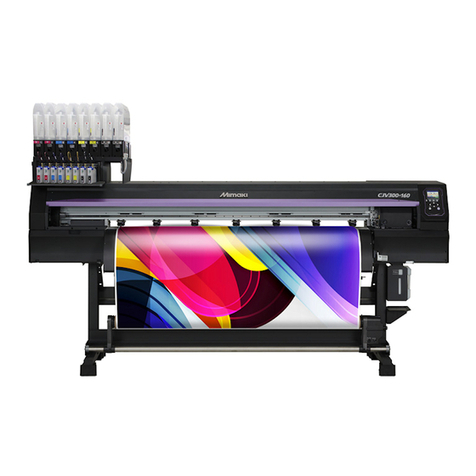
MIMAKI
MIMAKI CJV300-130 Operation manual
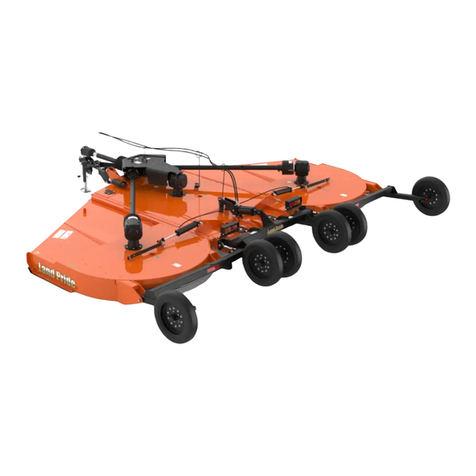
Land Pride
Land Pride RC5020 Series Operator's manual

Pattfield Ergo Tools
Pattfield Ergo Tools PE-650 FS manual
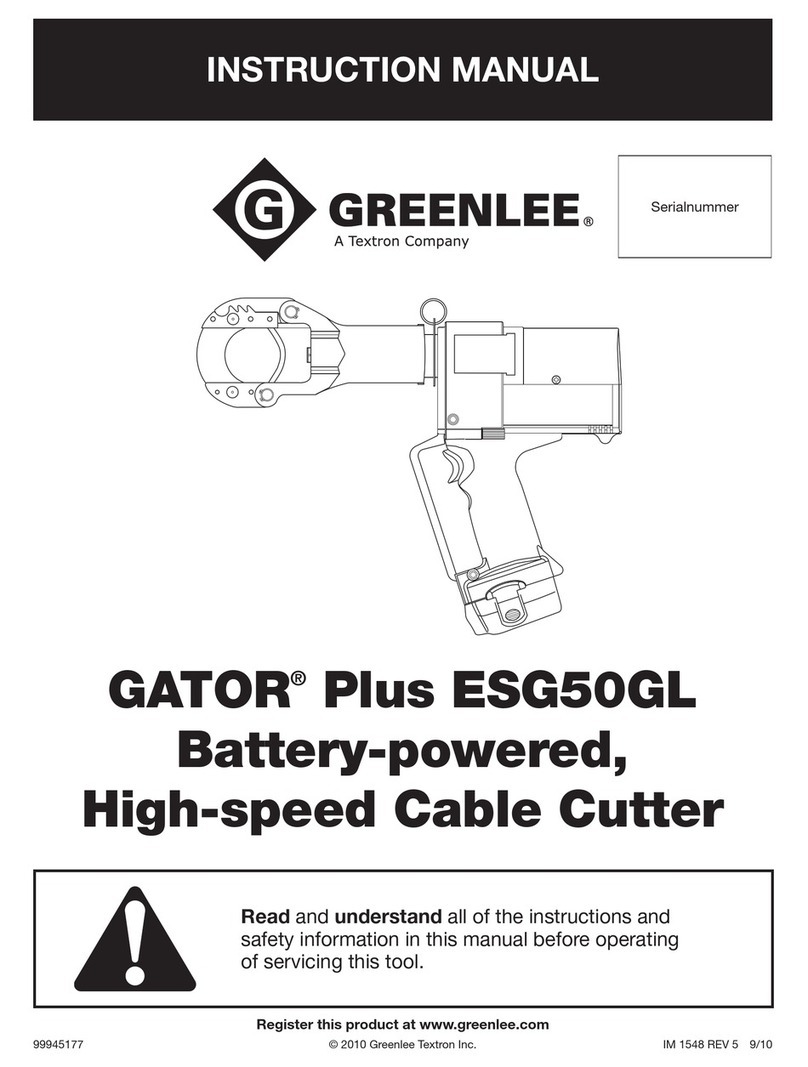
Greenlee
Greenlee GATOR Plus ESG50GL instruction manual
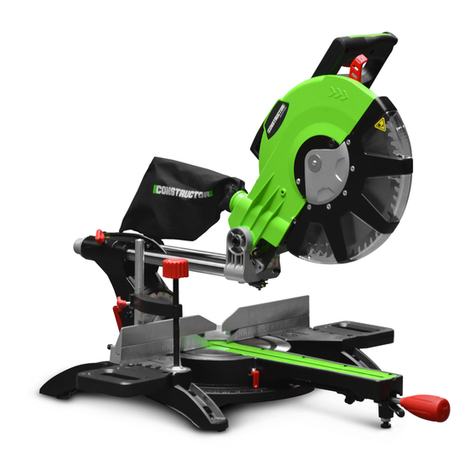
Constructor
Constructor CTRMS2100-305DBLA Original instructions

